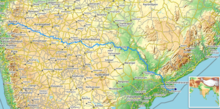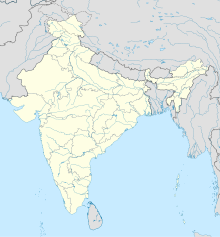|
Maratha invasion of Deccan (1739)
The Maratha invasion of the Deccan in 1739, led by Peshwa Bajirao I, was a military campaign of the Maratha Confederacy against the Nizam of Hyderabad. Bajirao's Maratha forces invaded Hyderabad's territories and had a military conflict with Nasir Jung, the son of Nizam-ul Mulk, Asaf Jah. Subsequently, a treaty was signed between the two parties. As per the terms, the Marathas relinquished their authority to collect taxes from the six provinces of Deccan, while Hyderabad fulfilled its earlier promise by ceding Khargaon and Handiya to the Marathas. BackgroundBetween 1738 and 1740, Nader Shah launched an invasion of India.[5] In response to this threat, Mughal Emperor Muhammad Shah summoned the Nizam of Hyderabad, Asaf Jah, to Delhi. Accepting the emperor's request, Asaf Jah mobilized his army and marched to Delhi in a bid to resist the invasion.[6][7] In the absence of the Nizam, Bajirao, the then Peshwa of the Maratha Empire, launched an attack on Hyderabad with the aim of capturing the six provinces of Deccan. Having already secured Malwa through the Battle of Bhopal from Jai Singh II, Bajirao sought to expand Maratha influence by targeting Hyderabad in the absence of the Nizam.[8][9] The invasionIn December 1739, Bajirao led a formidable force of 50,000 horse and foot soldiers towards Hyderabad. Nasir Jung, having received intelligence about the Marathas' intent to capture the Deccan in the absence of his father, mobilized 10,000 soldiers and marched against Bajirao. The Battle ensued after both parties crossed the Godavari River.[10] In the ensuing battle, according to some sources, Bajirao suffered defeat, and his army was compelled to make a humiliating peace treaty, marking a significant setback for the Maratha forces.[9][10] However, based on alternative accounts, Bajirao attempted to alleviate his sorrow through engaging in wartime activities. When his request for additional territories from the Nizam to establish a northern route was unsuccessful, he laid siege to Nasir Jang, the Nizam's son, in the Aurangabad fort, ultimately forcing him to relinquish the districts of Nemad and Khargon.[11] According to some historical sources, Peshwa Bajirao's last battle took place in Rawarkhedi, Madhya Pradesh in 1739, against Nasir Jung, the Nizam's son. Nasir Jung lost the battle and escaped.[12][13] AftermathFollowing the battle, Nasir Jung and Bajirao signed a treaty to formalize the terms and conditions, marking the conclusion of their military conflict. Acoording to the treaty: 1.) The Marathas were deprived of their authority to collect chauth from the six provinces of Deccan. 2.) Bajirao promised to not invade the Deccan again. 3.) Khargone and Handia, previously promised by the Nizam, were formally ceded to the Maratha Empire.[9] This marked the final military engagement for Bajirao, as he passed away in April 1740 following the conclusion of this conflict.[10][14] References
|
||||||||||||||||||||||||||||||


